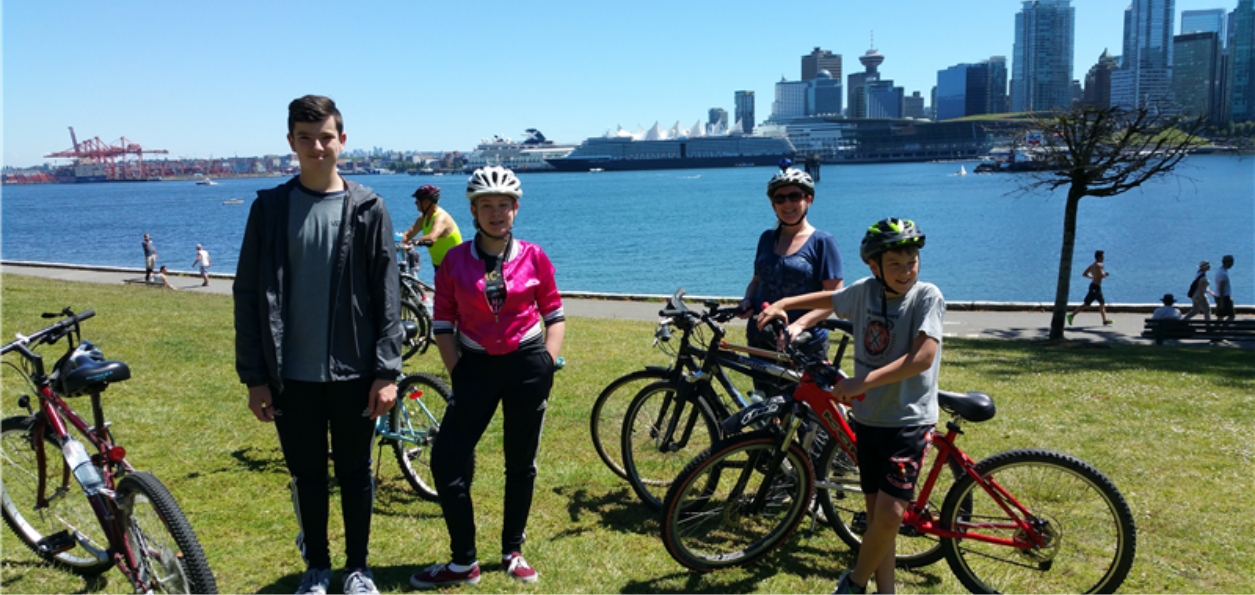We wanted to inspire our population to try active transportation to and from school. Many of them live close enough but thought it was too hard. We set up walk to school Wednesdays for the month of April with great participation. Then in May we tried a Two Week Challenge – students had to use active transportation to and from school every day for 2 weeks. They kept a log that was signed by a parent and a teacher. At the end students and parents wrote reflections. We used our HSN grant to offer great active prizes for completing the two weeks (ripstick, sports equipment and a trip to downtown Vancouver with a hotel stay and tickets to the aquarium). We had excellent participation and many participants commented that it was easier than they thought it would be, they enjoyed the time walking or cycling to school and that they would likely continue more often than before.
Our school is in a quiet residential area. In spite of having many safe routes to school, many of our students are driven. I believed that if they were challenged to use active transportation and the prizes were good enough, they would try it and find out that it is easier than they thought and maybe they could use active transportation more often.
Our inquiry question was: if students use an active mode of transportation to and from school for 2 weeks as part of a contest, will it have a lasting impact on their behavior?
We started in April – each Wednesday was a “Walk to School” Wednesday. Everyone who used an active mode of transportation to school had their name entered into a draw and we gave out prizes (bubbles, Frisbees, sidewalk chalk)
In May we challenged students to enter a two week challenge. They would have to use an active mode of transportation every day for 2 weeks and log their activity. Parents and teachers would need to sign the log. Again there would be a draw for prizes – students who completed the 2 week challenge were entered into the draw. The prizes were: ripstick, basketballs, soccer balls, along with the grand prize of a weekend in Vancouver and tickets to the Vancouver Aquarium for the family of the winner.
Our Green Team (students) and our Cool Routes to School (students) groups helped promote the events and select the prizes. We are part of an active transportation pilot with HASTe so students and their families were aware of the initiative. Staff were involved by promoting the contests with their classes. We sent emails home to parents to remind them. Our student announcers selected motivational music for each of the Walk to School Wednesdays (Walk of life, etc.)
Our outcomes included: Walk to School Wednesday – participants, Week 1 – 203, Week 2 – 215, Week 3 – 249, Week 4 – 258. (Note: School Population was 315)
Two Week Challenge – 200 students participated; 125 completed the challenge, using active transportation every day for 2 consecutive weeks in May, to school and returning home. Many parents participated with their students, either walking with them or cycling with them.
On their response forms, students and parents commented that there was a sense of community among people walking to school. As well, both children and parents commented that when parents walked their children to school, it was an excellent chance to connect and discuss the events of the day. Here is one of the representative quotes: “It was easy to support Jasmine as she was excited to walk to school and gave us a chance to talk about things in the neighbourhood and say hello to people and pets…I think we will be walking on a more regular basis”
I was amazed that the participation was so high and the comments so positive. A very small percentage of our population feels that it is not safe to walk to school. I think that if similar challenges are established in the Fall, people will likely continue to use more active transportation to school. I am retiring from my position as principal, but I am confident that the school will continue on their journey to more active transportation to school and less traffic in the parking lot.

